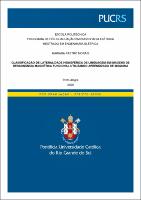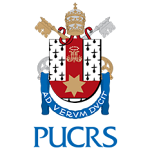| Share record |


|
Please use this identifier to cite or link to this item:
https://tede2.pucrs.br/tede2/handle/tede/9334Full metadata record
| DC Field | Value | Language |
|---|---|---|
| dc.creator | Morais, Mariana Pastro | - |
| dc.contributor.advisor1 | Silva, Ana Maria Marques da | - |
| dc.date.accessioned | 2020-11-06T12:54:39Z | - |
| dc.date.issued | 2020-03-27 | - |
| dc.identifier.uri | http://tede2.pucrs.br/tede2/handle/tede/9334 | - |
| dc.description.resumo | Embora a área cerebral de linguagem tenha sua localização anatômica definida pelas áreas de Wernicke e de Broca, alguns pacientes acometidos com tumores cerebrais têm suas topografias de ativação alteradas, devido a um fenômeno chamado translocação de linguagem. A ressonância magnética funcional (RMf) é um método de diagnóstico por imagem que evidencia as áreas de linguagem, contribuindo para um correto planejamento cirúrgico de retirada de tumores. Apesar da detecção das áreas de ativação cerebral por inspeção visual ser a mais utilizada na clínica, alguns trabalhos vêm utilizando técnicas de Aprendizado de Máquina, como Support Vector Machine, Regressão Logística, Árvores de Decisão, entre outras. Este trabalho tem como objetivo avaliar a aplicação de uma técnica de classificação de lateralidade hemisférica cerebral em área de linguagem utilizando Aprendizado de Máquina. Os coeficientes de ativação das áreas de interesse em imagens de RMf foram extraídos por meio do software AFNI. Uma rede neural artificial Multilayer Perceptron foi configurada, de modo a determinar a probabilidade de as áreas de linguagem estarem alocadas em determinado hemisfério cerebral. O desempenho da rede neural foi avaliado por meio da comparação estatística com o Índice de Lateralidade e com a análise visual. Os resultados mostraram que a RNA MLP tem potencial para ser um método auxiliar para classificação de lateralidade hemisférica cerebral em área de linguagem. | por |
| dc.description.abstract | Although the cerebral language area has its anatomical location defined by Wernicke’s area and Broca’s area, some patients affected with brain tumors have their activation topographies altered due to a phenomenon called language translocation. Functional Magnetic Resonance Imaging (fMRI) is a diagnostic imaging method that highlights language areas, contributing to the correct surgical planning of tumor removal. Despite the detection of brain activation areas by visual inspection being the most used at the clinic, some studies have been using Machine Learning techniques, such as Support Vector Machine, Logistic Regression, Decision Trees, and others. This work aims to evaluate the application of a technique for classification language area laterality to be using Machine Learning. The activation coefficients of the areas of interest in fMRI images were extracted using the AFNI software. A Multilayer Perceptron artificial neural network was set up in order to determine the probability of the language area are allocated in a certain cerebral hemisphere. The performance of the neural network was assessed by means of statistical comparison with the Laterality Index and the visual analisys. The results showed that MLP RNA has the potential to be an auxiliary method for classifying cerebral hemispheric laterality in the language area. | eng |
| dc.description.provenance | Submitted by PPG Engenharia Elétrica ([email protected]) on 2020-08-19T19:46:00Z No. of bitstreams: 1 MARIANA PASTRO MORAIS_DIS.pdf: 1371113 bytes, checksum: 6e4261037da0fb746e250733e65c06ae (MD5) | eng |
| dc.description.provenance | Approved for entry into archive by Sheila Dias ([email protected]) on 2020-11-06T12:49:40Z (GMT) No. of bitstreams: 1 MARIANA PASTRO MORAIS_DIS.pdf: 1371113 bytes, checksum: 6e4261037da0fb746e250733e65c06ae (MD5) | eng |
| dc.description.provenance | Made available in DSpace on 2020-11-06T12:54:39Z (GMT). No. of bitstreams: 1 MARIANA PASTRO MORAIS_DIS.pdf: 1371113 bytes, checksum: 6e4261037da0fb746e250733e65c06ae (MD5) Previous issue date: 2020-03-27 | eng |
| dc.format | application/pdf | * |
| dc.thumbnail.url | http://tede2.pucrs.br:80/tede2/retrieve/179338/MARIANA%20PASTRO%20MORAIS_DIS.pdf.jpg | * |
| dc.language | por | por |
| dc.publisher | Pontifícia Universidade Católica do Rio Grande do Sul | por |
| dc.publisher.department | Escola Politécnica | por |
| dc.publisher.country | Brasil | por |
| dc.publisher.initials | PUCRS | por |
| dc.publisher.program | Programa de Pós-Graduação em Engenharia Elétrica | por |
| dc.rights | Acesso Aberto | por |
| dc.subject | Ressonância Magnética Funcional | por |
| dc.subject | Aprendizado de Máquina | por |
| dc.subject | Neurolinguagem | por |
| dc.subject | Lateralidade Hemisférica Cerebral | por |
| dc.subject | Functional Magnetic | eng |
| dc.subject | Resonance | eng |
| dc.subject | Machine Learning | eng |
| dc.subject | Neurolanguage | eng |
| dc.subject | Cerebral Hemispheric Laterality | eng |
| dc.subject.cnpq | ENGENHARIAS | por |
| dc.title | Classificação de lateralidade hemisférica de linguagem de linguagem em imagens de ressonância magnética funcional utilizando aprendizado de máquina | por |
| dc.type | Dissertação | por |
| dc.restricao.situacao | Trabalho não apresenta restrição para publicação | por |
| Appears in Collections: | Programa de Pós-Graduação em Engenharia Elétrica | |
Files in This Item:
| File | Description | Size | Format | |
|---|---|---|---|---|
| MARIANA PASTRO MORAIS_DIS.pdf | MARIANA_PASTRO_MORAIS_DIS | 1.34 MB | Adobe PDF |  Download/Open Preview |
Items in DSpace are protected by copyright, with all rights reserved, unless otherwise indicated.




